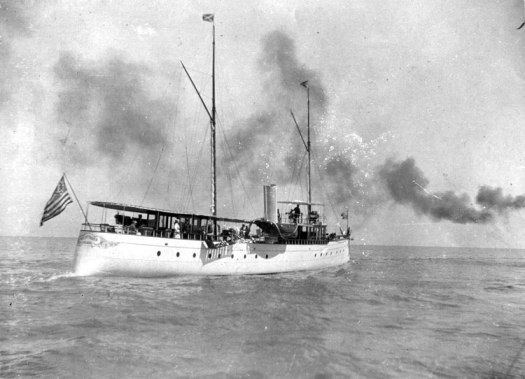Most people are familiar with the America’s Cup, the sailboat race which has attracted prominent competitors such as Sir Thomas Lipton and Ted Turner. What most people don’t know is that there is a fresh water counterpart to that race, the Canada’s Cup, sailed on the Great Lakes. The genesis of that race, how the Americans lost it the first time and gained it back the second, is one of the most interesting in yachting history.
In 1896 the Lincoln Park Yacht Club in Chicago challenged the Royal Canadian Yacht Club in Toronto to a cross-Great Lakes race. The first race was held that year in Toledo, OH. The Canadians were victorious, thus they named the race the Canada’s Cup.
In the same year, another member of the Lincoln Park club, Chicago rubber magnate Fred W. Morgan, commisioned the building of his new yacht, the Pathfinder. Built in Racine, WI, its maiden voyage to Chicago was “the event of the season,” and people gathered on the docks to watch it glide into the harbour. The Pathfinder was 140′ long (a sizeable yacht then or now) and resembled the U.S. Navy’s battleships of the day. It had telephones and electric lighting in an era when the vast majority of American homes had neither.
Below: the Pathfinder, under way on the Great Lakes.
Two years later the Chicago Yacht Club, with Fred Morgan as its Commodore and the Pathfinder the club’s flagship, issued a challenge to the RCYC for the Canada’s Cup. The following year the Pathfinder steamed from Chicago to Toronto for the rematch.
The first day of racing was 21 August 1899. The object was to start near the RCYC, round two buoys, and return to the club. The Canadians’ yacht, the Beaver, had an accident right at the start and was out of the race. The American yacht, the Genessee, had a chance for a default for the first race (it was two out of three to win.)
But such was not to be. The Pathfinder was acting as a kind of “pace yacht” for the race, but in the haze on Lake Ontario itself got lost and missed the first buoy. Behind it was not only the Genessee but steam yachts Siren and Canada! The entire entourage mistook another buoy for the first official one, where the judges’ ship waited in vain.
Because of this the Americans missed the chance for a forfeit. We eventually (and when I say “we” I mean not only the Americans but the Chicago Yacht Club, where my great-grandfather was Commodore the following year) won the race, but only by 31 seconds on a five hour course.
In those days it was easy for everyone to follow the largest, most magnificent yacht on the Great Lakes. But they still got lost. Unfortunately things haven’t changed as much as we would like to think.
Our country and our world is directed by those who are supposedly the most educated and enlightened among us. Yet we still experienced the crash of 2008 and its aftermath. Many of us were participants in that by virtue of taking out loans on our houses and just about everything else we owned (and didn’t in some cases) because were were informed by “knowledgeable” people that we could afford it. That’s little comfort now that those homes and possessions are going away in foreclosure and repossession, especially since many of us are without income.
We have also been directed for the last forty years by a “knowledge class” that assured us that our “old ways” were hopelessly passé and that we would be happier in our new family structures. In a country with high divorce and incarceration rates and single-parent poverty, their self-confident assurances aren’t much comfort either.
In the end the only one we can trust for the truth is he that is the truth, Jesus Christ. Through him all things were created, so he is most knowledgeable as to what we need. And, of course, he is the real “pathfinder” from the ultimate challenge of life, death itself, as we walked out of the tomb after those who didn’t care for his challenge of their authority had him executed.
It’s time for all of us who have followed what looked to be the biggest and most magnificent thing “on the water” to turn to he who actually walked on it.

